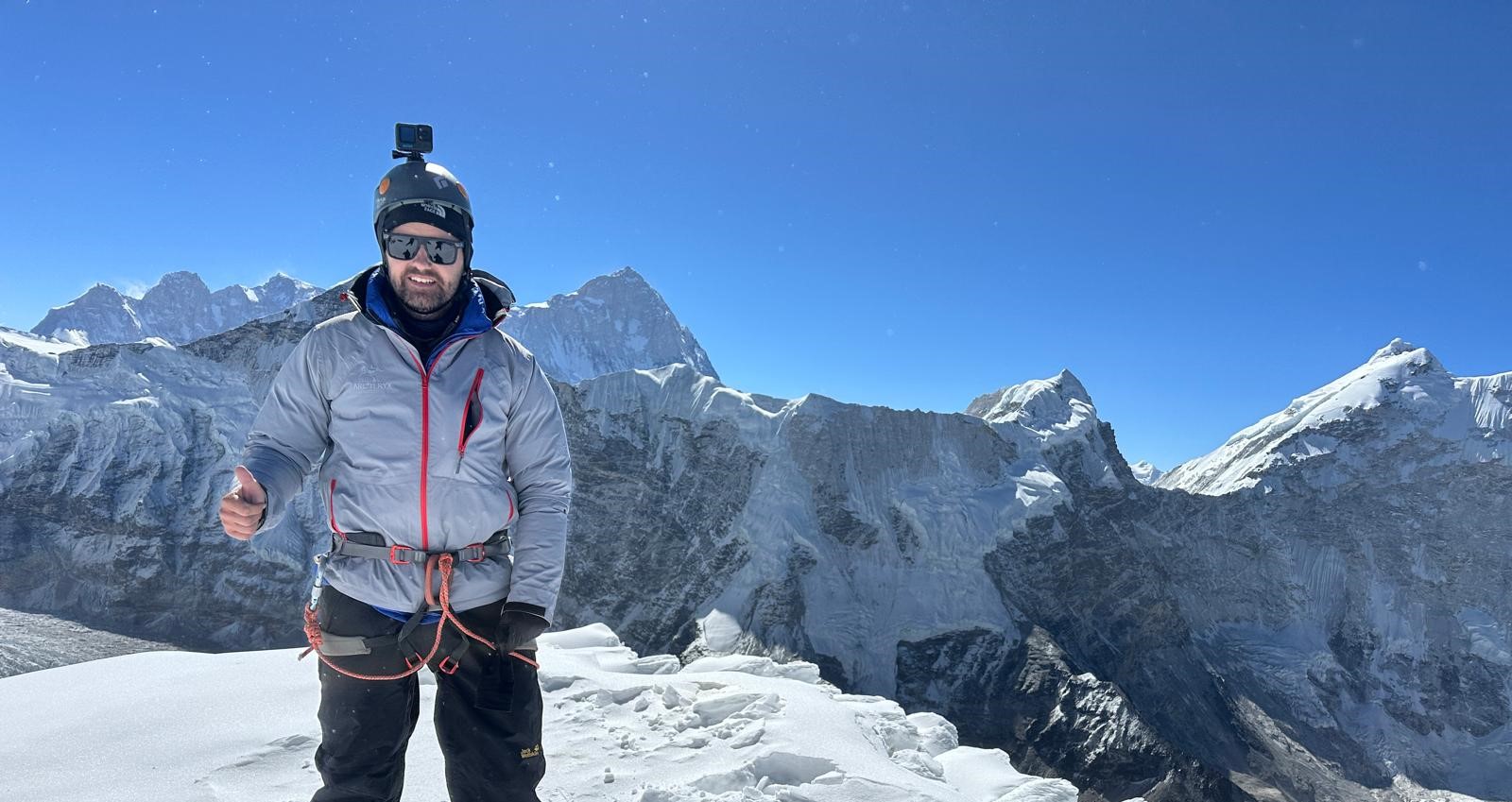ISLAND PEAK CLIMBING 10 DAYS
Island Peak Climbing is one of the most sought-after climbing adventures in the Himalayas, offering trekkers the chance to summit a 6,165-meter peak with stunning panoramic views. This thrilling trek, typically completed in 10 days, is ideal for those who have experience with high-altitude trekking and basic mountaineering skills. The journey begins with a scenic flight from Kathmandu to Lukla, followed by a trek through the stunning Everest region, passing through vibrant Sherpa villages, lush forests, and crossing suspension bridges that connect you to the heart of the mountains.
The trek to Island Peak includes several acclimatization days, crucial for ensuring your body adjusts to the increasing altitude. You will spend time in key spots like Namche Bazaar, Pangboche, and Chhukung, allowing your body to acclimatize while enjoying breathtaking views of Everest, Ama Dablam, and other towering peaks. One of the highlights of the trip is the hike to Ama Dablam Base Camp, which provides stunning views of one of the most beautiful peaks in the Himalayas. The combination of trekking and mountaineering training helps climbers prepare for the final summit push.
At Island Peak Base Camp, you will prepare for the challenging ascent, which includes glacier travel, steep snow slopes, and sections of fixed rope climbing. Summiting Island Peak is a true test of endurance and climbing skills, but the reward is unparalleled—breathtaking 360-degree views of Mount Everest, Lhotse, Makalu, and other peaks in the Everest region.
After the climb, trekkers descend to Chhukung and take a helicopter back to Lukla, reducing the physical strain of long descents. From Lukla, a flight back to Kathmandu completes this unforgettable Himalayan adventure.
Island Peak Climbing offers an exciting blend of trekking, mountaineering, and cultural immersion, making it a once-in-a-lifetime experience for adventure seekers looking to challenge themselves in the heart of the Himalayas.
ITINERARY
Day 1 : Flight to Lukla (2,860m) & Trek to Phakding (2,610m) Duration: 4–5 hours.
Your adventure begins with a thrilling scenic flight from Kathmandu to Lukla, which provides breathtaking views of the Himalayas. Once in Lukla, you'll start the trek to Phakding, walking through Sherpa villages and pine forests, and crossing the Dudh Koshi River. After a 4–5 hour trek, you’ll reach Phakding to rest overnight and prepare for the next day’s trek.
Day 2 : Trek from Phakding to Namche Bazaar (3,440m) Duration: 5–6 hours.
Today’s trek takes you through a beautiful forest, crossing several suspension bridges, including the famous Hillary Suspension Bridge. The trail gradually climbs as you approach Namche Bazaar, the bustling Sherpa capital. On arrival, you’ll get your first glimpse of Mount Everest and surrounding peaks, making this a memorable day. After a long day’s trek, you’ll rest in Namche.
Day 3 : Acclimatization Day in Namche Bazaar.
To help your body adjust to the increasing altitude, you’ll spend a full day in Namche Bazaar for acclimatization. You can take a short hike to the Everest View Hotel for panoramic views of Everest, Lhotse, Ama Dablam, and more. You can also explore Khunde and Khumjung villages or visit the Sherpa Museum to learn about the region’s culture and history.
Day 4 : Trek from Namche to Pangboche (3,930m) Duration: 5–6 hours.
Today’s trek takes you through beautiful forests and Dudhkoshi River valleys to Tengboche, where you’ll have the chance to visit the famous Tengboche Monastery. Continuing your trek, you’ll arrive in Pangboche, a small village offering stunning views of Ama Dablam, one of the most iconic peaks in the Everest region. This will be a great place to rest and acclimatize further.
Day 5 : Acclimatization Day at Pangboche & Hike to Ama Dablam Base Camp (4,600m) Duration: 4–5 hours
You’ll spend the day in Pangboche for further acclimatization. A highlight of this day will be a hike to the Ama Dablam Base Camp, offering incredible views of Ama Dablam and other surrounding peaks. This acclimatization hike helps you adjust to the higher altitudes while enjoying the majestic beauty of the mountains. After the hike, you’ll return to Pangboche for the night.
Day 6 : Trek from Pangboche to Chhukung (4,730m) Duration: 5–6 hours.
The trek from Pangboche to Chhukung takes you through the Imja Valley with spectacular views of Ama Dablam and other peaks. As you gradually ascend, you’ll cross bridges and walk through alpine meadows before reaching Chhukung, a small settlement at the foot of Island Peak. This is another key acclimatization stop before your summit push.
Day 7 : Acclimatization Day – Hike to Chhukung Ri (5,550m) Duration: 5–6 hours.
Today is another acclimatization day. You’ll hike up to Chhukung Ri (5,550m), which offers spectacular panoramic views of the surrounding Himalayan peaks, including Island Peak, Makalu, and Lhotse. The goal of the hike is to help your body adjust to the altitude, while giving you a chance to take in some of the most stunning views of the trip. You’ll return to Chhukung for the night.
Day 8 : Trek from Chhukung to Island Peak Base Camp (5,100m) Duration: 5–6 hours.
From Chhukung, you’ll trek towards Island Peak Base Camp. This portion of the trek involves rocky moraines and crossing glacial streams, offering magnificent views of the surrounding peaks. Once you reach Base Camp, you’ll settle in and prepare for the next day’s summit attempt. Here, you’ll meet with your climbing team, check your gear, and go over the climb details.
Day 9 : Summit Island Peak (6,165m) & Return to Chhukung Duration: 10–12 hours.
Summit day! You’ll start early in the morning and ascend towards the summit of Island Peak (6,165m). The climb involves glacier travel, steep snow and ice slopes, and sections where fixed ropes are required. The summit rewards you with unmatched views of Mount Everest, Makalu, Lhotse, and surrounding peaks. After taking in the breathtaking views and celebrating your achievement, you’ll descend back to Chhukung to rest and recuperate.
Day 10 : Trek to Dingboche, Helicopter to Lukla & Fly to Kathmandu.
After descending to Chhukung, you’ll trek back to Dingboche for a rest. From Dingboche, you’ll board a helicopter flight to Lukla, offering a thrilling aerial view of the Himalayas. From Lukla, you’ll take a regular flight back to Kathmandu, marking the end of this unforgettable Island Peak climbing adventure.
SERVICES
Costs Included in Your Package
- Domestic Airport Pick-Up and Drop-Off: Private car or jeep transfer from/to the airport for your convenience and comfort.
- Meals During the Trek: Three nutritious meals per day (breakfast, lunch, and dinner), including fresh fruit served each evening after dinner.
- Scenic Helicopter Transfer: Shared helicopter flight from Dingboche to Lukla, offering a spectacular aerial view of the Himalayas.
- Accommodation: Comfortable trekking lodge (tea house) stays during the trek, and tented camp accommodation during the Island Peak climbing session.
- Permits and Entry Fees: All necessary paperwork, including the Sagarmatha National Park Entry Permit and Khumbu Pasang Lhamu Rural Municipality fees.
- Flights and Transfers: Round-trip domestic flights (Kathmandu–Lukla–Kathmandu via Ramechhap) with private airport transfers and applicable airport taxes.
- Experienced Trekking and Climbing Guide: An English-speaking, government-licensed guide who is friendly, knowledgeable, well-trained, and fully insured—covering all his expenses including salary, food, accommodation, transport, and insurance.
- Island Peak Climbing Permit: Official permit for climbing Island Peak.
- Sherpa Porters: Reliable, helpful Sherpa porters (one for every two trekkers) equipped with proper safety and walking gear. Their salary, meals, accommodation, and insurance are covered.
- Medical Support: A Comprehensive first aid kit is available throughout the trek for your safety and peace of mind.
- Emergency Helicopter Arrangement: Coordination of emergency helicopter evacuation (covered by your personal travel insurance, if required).
- Essential Trekking Gear (On Loan): Complimentary use of sleeping bag, down jacket, duffel bag, and walking poles (to be returned after the trek).
- Exclusive Souvenirs: Sherpa Expedition & Trekking T-shirt and a trip achievement certificate upon successful trip completion.
- Health Monitoring: Daily use of an oxygen meter to monitor your pulse, oxygen saturation, and heart rate—crucial for detecting early signs of Altitude Mountain Sickness (AMS).
- Assistant Guide: An additional assistant guide will be provided for groups of 8 or more trekkers to ensure safety and personalized attention.
- Government Fees and Taxes: All government taxes and official expenses are included.
Costs Excluded from Your Package
- Meals in Kathmandu: Lunch and dinner while staying in Kathmandu are not included.
- Hotel Accommodation in Kathmandu: Accommodation in Kathmandu before or after the trek is not covered.
- Nepal Entry Visa: The Nepal visa fee is not included. Visas are available on arrival at Tribhuvan International Airport:
- $30 USD for 15 days
- $50 USD for 30 days
- $125 USD for 90 days
- Travel & Medical Insurance: Personal travel and medical insurance (mandatory for trekking and climbing).
- International Airfare: Flights to and from Nepal are not included.
- Personal Expenses: Any personal spending such as souvenirs, laundry, and snacks.
- Drinks & Snacks During the Trek: Alcoholic and non-alcoholic beverages (including tea, coffee, soup, hot chocolate, cocoa, bottled water), as well as any extra food items purchased along the way or at tea houses (e.g., additional meals, snacks, desserts like chocolate, cake, pudding, etc.).
- Extras at Tea Houses: Charges for hot showers, Wi-Fi, and battery charging at trekking lodges are not included.
- Tips: Gratuities for guides, porters, and drivers (tipping is customary and appreciated).
- Excess Baggage Fees: Extra baggage over 10 kg on the Lukla flight may incur additional fees.
- Early Return from Trek: In case of an early return due to illness or any unforeseen reason, the cost of unused services (flights, accommodations, meals, etc.) is non-refundable. Any additional expenses in Kathmandu (hotel, meals, etc.) will be your responsibility.
EQUIPMENTS
You’ll carry your personal gear and share some group equipment, so pack light with layered, weather-appropriate clothing—avoid cotton and choose breathable, insulating fabrics. A windproof duffle (provided and carried by porters) and water are included. Non-trekking items can be stored in Kathmandu. Sherpa Expedition & Trekking supplies all essential expedition gear.
Upper Body:
- Base Layers: Moisture-wicking and quick-drying shirts and thermal tops.
- Insulation Layers: Fleece or down jackets to provide warmth.
- Waterproof Shell Jacket: A durable and breathable jacket to protect against wind and rain.
- Softshell Jacket: A lightweight and water-resistant jacket for added protection.
- Climbing Harness: A comfortable harness to secure yourself to the rope.
- Helmet: A strong and well-fitting helmet to protect your head from falling objects.
- Gloves: A combination of lightweight liner gloves and insulated gloves or mittens for warmth and dexterity.
- Buff or Neck Gaiter: To protect your neck and face from cold and wind.
- Sunglasses: Polarized and UV-protected sunglasses to shield your eyes from the sun and snow glare.
- Goggles: Ski or mountaineering goggles for added eye protection in extreme weather conditions.
Lower Body:
- Base Layers: Moisture-wicking and quick-drying thermal bottoms.
- Insulation Layers: Fleece or insulated pants for added warmth.
- Waterproof Shell Pants: Durable and breathable pants to protect against wind, rain, and snow.
- Softshell Pants: Lightweight and water-resistant pants for added protection.
- Mountaineering Boots: Sturdy and insulated boots designed for snow and ice.
- Crampons: Attachable spikes that provide traction on icy terrain.
- Gaiters: Waterproof and breathable gaiters to keep snow out of your boots.
- Socks: A combination of moisture-wicking liner socks and thick, warm mountaineering socks.
Other Essential Items:
- Backpack: A spacious and sturdy backpack to carry your climbing gear and personal belongings.
- Sleeping Bag: A warm and lightweight sleeping bag that can withstand sub-zero temperatures.
- Trekking Poles: Adjustable trekking poles for added stability and support.
- Headlamp: Essential for climbing in low-light or dark conditions.
- Water Bottles: Insulated water bottles to keep your water from freezing.
- Sunscreen: High SPF sunscreen to protect your skin from the strong sun at high altitudes.
- First Aid Kit: A comprehensive first aid kit with essential medications and supplies.
- Climbing Snacks: Energy bars, nuts, and other lightweight snacks for quick fuel during the climb.
It is important to invest in high-quality gear and ensure that everything fits properly and is in good condition. Additionally, consult with experienced climbers or a professional guide to ensure you have all the necessary gear and receive proper training on how to use it effectively and safely.
Note: Essential climbing equipment, including an ice axe, crampons, climbing boots, harness, helmet, safety rope, ascender (jumar), and carabiner, can be hired in Chhukung. The total cost is approximately USD 120 per person for a complete set.
GOOD TO KNOW
🏞️ Best Time to Climb Island Peak
The best time to climb Island Peak is during spring (March to May) and autumn (September to November). During these months, the weather is relatively stable with clear skies, making for a safer and more enjoyable climb. The temperature is also moderate compared to the harsh winter cold and summer monsoon rains. However, spring offers the best chances for clear mountain views, while autumn provides good weather with fewer trekkers.
🛠️ Required Experience & Fitness Level
Island Peak Climbing is designed for trekkers with prior high-altitude trekking experience and some basic mountaineering skills. You should be in excellent physical condition to handle the challenges of trekking at high altitudes and participating in the technical aspects of the climb, such as glacier travel, fixed ropes, and steep ascents. Previous experience with ice axes, crampons, and rope techniques will be helpful but not required, as guides will provide necessary training before the summit push.
🎒 What to Pack for Island Peak Climbing
When preparing for Island Peak, packing the right gear is crucial. Essential items include trekking boots, warm clothing, sleeping bags rated for extreme cold, mountaineering gloves, and crampons for the summit push. Don’t forget items like sunglasses, sunblock, a headlamp, and personal medications. If you're unsure about what to bring, local gear shops in Kathmandu or Namche Bazaar offer rentals for many items.
🏨 Accommodation on the Trek
During the trek, accommodation will primarily be in teahouses, which are simple yet comfortable lodges offering beds, basic food, and shelter. In higher altitudes, teahouses are more basic, but they still provide a warm, welcoming place to rest. Island Peak Base Camp has tented camps, where climbers will sleep during the summit attempt. Hot meals are available throughout the trek, with typical dishes including dal bhat, momos, and noodles.
⏳ Acclimatization is Key
Acclimatization days are an essential part of the trek, especially when trekking at high altitudes like those found in the Everest region. Spending extra time in places like Namche Bazaar, Pangboche, and Chhukung allows your body to adjust to the lower oxygen levels. This significantly reduces the risk of acute mountain sickness (AMS) and helps ensure a safe and successful summit. Acclimatization also includes short hikes to higher altitudes during rest days.
🚁 Helicopter Return from Chhukung
A major perk of this trek is the helicopter ride from Chhukung to Lukla after the summit. This scenic flight not only reduces the strenuous descent but also provides incredible aerial views of the Himalayas. This helicopter service ensures that trekkers can return to Lukla in comfort, making for a quicker and safer journey back to Kathmandu.
MAP
PHOTOS/Videos
Departures
Select a departure month
Fill out the form below and a Travel Expert will reach out to create your perfect tour.
FAQS
What is Island Peak Climbing?
Island Peak Climbing is a challenging and thrilling mountaineering expedition in Nepal. It involves summiting Island Peak (6,165m), a trekking peak in the Everest region, known for its stunning views of the surrounding mountains, including Mount Everest, Makalu, and Lhotse.
Do I need mountaineering experience for Island Peak Climbing?
While prior mountaineering experience is not mandatory, it is recommended to have high-altitude trekking experience and basic climbing skills. If you are unfamiliar with equipment like ice axes and crampons, your guides will provide necessary training before the summit attempt.
How long does it take to summit Island Peak?
The Island Peak Climbing expedition typically lasts 9 to 12 days, depending on your route and acclimatization needs. The summit day is physically demanding and usually takes between 10 to 12 hours.
When is the best time to climb Island Peak?
The best times to climb Island Peak are in spring (March-May) and autumn (September-November). These seasons offer favorable weather conditions with clear skies, dry trails, and less risk of extreme weather.
What kind of fitness level is required for this climb?
You should be in excellent physical condition, able to walk for several hours a day with a daypack, and handle the physical challenges of climbing at high altitudes. Cardiovascular fitness, strength, and endurance are key to succeeding in this climb.
How high is Island Peak?
Island Peak stands at 6,165 meters (20,224 feet) above sea level, making it one of the most popular trekking peaks in Nepal. Its summit offers unparalleled views of Everest, Lhotse, Makalu, and other nearby peaks.
What is the accommodation like during the trek?
Accommodation along the trek is provided in teahouses, simple lodges that offer basic facilities like beds, food, and shelter. At Island Peak Base Camp, you will sleep in tented camps with the support of professional climbing staff.
Is altitude sickness a concern?
Yes, altitude sickness is a risk when trekking at high altitudes like those on the Island Peak climb. To minimize the risk, you’ll spend extra time acclimatizing in key locations such as Namche Bazaar, Pangboche, and Chhukung, which helps your body adjust to the thinner air.
What gear is needed for Island Peak Climbing?
You will need mountaineering equipment like crampons, ice axes, and climbing boots, as well as trekking gear like sleeping bags, warm clothes, and headlamps. Some items can be rented in Kathmandu or Namche Bazaar, but it’s recommended to have your essential gear ready before departure.
How do I get back to Kathmandu after the climb?
After summiting Island Peak, you will trek back to Chhukung and take a helicopter ride to Lukla. From Lukla, you will catch a regular flight back to Kathmandu, completing the journey in comfort and safety.
Latest Traveller’s Reviews
Travel experiences of our clients who recently returned from their trips.
100%
Based On 896 Reviews
Reena Kuhrram
United States
September 17, 2024
Wonderful Experience from Start to Finish
I had a wonderful experience trekking to Everest Base Camp with Sherpa Expedition and Teams. The level of professionalism and care was evident from the start. Our guides were excellent at facilitating our acclimatization and ensuring everyone was in good spirits. The breathtaking landscapes and the warm hospitality in the teahouses made the trek unforgettable. I felt a true sense of camaraderie with fellow trekkers, all thanks to the fantastic atmosphere the Sherpa team created.
Daniella Garcia
Austria
September 2, 2024
Unforgettable Journey
My trek to Everest Base Camp with Sherpa Expedition Teams was nothing short of magical. The guides were incredibly knowledgeable and attentive, ensuring our safety and comfort throughout the journey. The breathtaking views, especially of Khumbu Glacier, left me in awe. Every meal was delicious, and the teahouses were cozy. I felt genuinely supported every step of the way. I highly recommend Sherpa Expedition for anyone seeking an adventure of a lifetime!
Laurence Fang
United States
August 29, 2024
Epic Adventure!
Trekking with Sherpa Expedition and Teams was an epic adventure. Their expertise in organizing the trek was apparent, and our guide was a wealth of knowledge. The trek itself was challenging yet thrilling, with stunning views that took my breath away. I felt safe and supported throughout, and the local culture added an enriching layer to the experience. Reaching Everest Base Camp was a dream realized. I wholeheartedly recommend this team for anyone looking for an incredible trek!
People Considering This Package Right Now Check availability
























